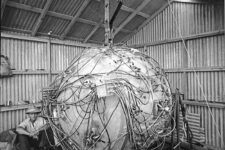
The Tragic Tale of the Japanese Balloon Bomb Attack
Amidst the global turmoil of World War II, an unconventional and largely forgotten attack unfolded across the vast Pacific Ocean. From November 1944 to April 1945, fueled by a desire for retaliation after the Doolittle Raid on Tokyo, Japan launched over 9,000 balloon bombs towards the unsuspecting Western United States.
These paper and silk contraptions, carrying both incendiary and anti-personnel explosives, posed a unique threat. Silent and unpredictable, they drifted on high-altitude winds, masking their potential for devastation beneath an innocent facade.
While most of these balloons landed harmlessly, the attack wasn’t without consequence. The peaceful town of Bly, Oregon, witnessed the grim reality of this unconventional warfare on May 5, 1945.
Reverend Archie Mitchell, his pregnant wife Elsie, and five Sunday school children embarked on a seemingly idyllic picnic.
But their joyful outing took a tragic turn when they encountered a seemingly harmless balloon.
Unaware of the hidden danger, a child reached for it, triggering an explosion that claimed the lives of Elsie and all five children. This marked the only casualties on U.S. soil directly caused by enemy action during the entire war.
The Bly tragedy exposed the vulnerability of the seemingly untouched American mainland. Despite their seemingly low-tech nature, the balloon bombs posed significant threats.
They could ignite wildfires, spread biological agents (though thankfully never used), and cause widespread panic. However, the U.S. government, fearing public anxiety and potentially aiding the enemy, opted for a different approach.
They instituted a media blackout, keeping the balloon attacks under wraps. This decision, while intended to protect both lives and information, left the public unprepared for the dangers lurking in the skies above.
Countering these attacks presented significant challenges. Deciphering the origin and trajectory of these wind-borne explosives proved difficult.
However, a crucial clue emerged in early December 1944 when two balloons recovered in Alaska revealed sandbags attached with sand composition unique to specific beaches on Japan’s Honshu Island.
To counter this aerial threat, the U.S. Army Air Forces and Navy initiated intercept missions to shoot down the balloons.
Additionally, army personnel and aircraft were stationed at strategic points to manage any resulting forest fires, and supplies of decontamination chemicals were discreetly distributed across the western United States.
Despite these measures, the balloon bomb attacks ceased before the U.S. could implement detailed defensive strategies, as Japan discontinued the attacks in April 1945, discouraged by their apparent lack of success.









